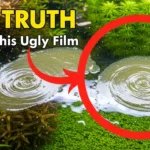It’s the moment that sends a jolt of panic through every new aquarium owner. You wake up, walk over to your beautiful tank, and it’s no longer the crystal-clear world you were so proud of. Instead, it’s filled with a hazy, milky, or greenish cloud that makes it hard to even see your fish. Your first thought is likely, “why is my fish aquarium cloudy and did I do something terribly wrong?”
Let me start by saying: take a deep breath, and do not panic.
What you are seeing is the single most common hiccup in the aquarium hobby. In fact, it’s a normal, predictable part of the process for almost every single new aquarium. It is not a sign that you have failed, and it is almost always easy to fix without buying a single thing.
As someone who has guided countless beginners through this exact situation, I can tell you that cloudy water is rarely the disaster it appears to be. It’s simply your aquarium’s way of telling you that it’s coming to life. Today, we’re going to play detective. We will diagnose exactly what kind of cloudy water you have, understand the simple science behind it, and lay out a clear, calm plan to get your tank back to being sparkling clear.
The First Step: Is Your Water White/Gray or Green?
This is the most important question you need to answer, and it will tell you everything you need to know. The color of the cloudiness is a direct clue to its cause. Stand back from your tank, look at it from the side, and really observe the color.
- Is the water a milky, hazy, grayish-white color? Does it look like someone poured a little bit of milk into your tank? If so, you are almost certainly dealing with a Bacterial Bloom.
- Is the water distinctly green? Does it look like a very faint (or very strong) pea soup? If so, you are dealing with a free-floating Algae Bloom.
Once you’ve identified the color, you can skip right to the section that applies to you. This simple diagnostic step is the key to understanding why is my fish aquarium cloudy.
If Your Water is White/Gray: The “New Tank” Bacterial Bloom

If your water has that milky, grayish-white haze, let me be the first to say: congratulations!
That probably sounds insane, but what you are seeing is a beautiful, natural process. This is a bacterial bloom, and it’s a sign that your aquarium’s invisible ecosystem is roaring to life. This is, by far, the most common reason for cloudy water, especially in tanks that are between one week and two months old.
- What’s Happening in Simple Terms? Think of your new tank as a brand new city. When the first residents (your fish) move in, they start producing trash (ammonia from waste). Suddenly, the city’s sanitation department (beneficial bacteria) realizes there’s a job to do. They reproduce at an explosive rate to handle all the new trash. This massive, sudden population boom of bacteria floating in the water is what creates that milky, hazy appearance. It’s “new tank syndrome” in its most visible form.
- Is It Harmful to My Fish? In most cases, no. The bacteria themselves are harmless. However, the bloom is a giant, flashing sign that your nitrogen cycle is in its early stages. This means you should be testing your water for toxic ammonia and nitrite, as these are the real dangers during this phase. The cloudiness itself is just a symptom of this process.
- The #1 Solution: Do Absolutely Nothing. This is the hardest advice for a worried beginner to follow, but it is the absolute best advice. This bacterial bloom is a temporary and necessary phase. You have to let it run its course. As the bacteria finish their population boom and find permanent homes on your filter media and substrate, the water will clear up on its own. This usually takes anywhere from a few days to a week.
- What NOT to Do (This is Important!):
- Do not do a massive water change. This is a classic beginner mistake. It might clear the water for a few hours, but you’re just giving the bacteria fresh, clean water to multiply in again, which can actually make the bloom last longer.
- Do not add “water clarifier” chemicals. These products are a gimmick. They work by clumping the microscopic bacteria together into larger particles. This can clog your fishes’ gills and can actually starve your filter of the very bacteria it needs to establish a healthy cycle. Just leave it alone.
If Your Water is Green: The Algae Bloom

If your water looks like a green soup, you are dealing with a completely different issue: a free-floating algae bloom. This is microscopic algae that is suspended and multiplying in the water itself. Don’t worry, this is also very common and very fixable.
- What’s Happening in Simple Terms? An algae bloom is caused by an imbalance of the two things all algae craves: light and nutrients. If you have too much of one or both, and your primary plants can’t use it all, the algae will happily step in and take over.
- The Most Common Causes:
- Too Much Light: This is the prime suspect. Is your aquarium light on for more than 8 hours a day? Is your tank sitting in a spot where it gets hit with direct sunlight from a window for a few hours? You’ve likely found your problem.
- Too Many Nutrients: Are you feeding your fish more than they can eat in a minute? Are there high levels of nitrates in your water? Excess nutrients are rocket fuel for an algae bloom.
- The Solution: Correct the Imbalance.
- Control the Light: Immediately cut your lighting period down to 6 hours per day. Use a timer to be consistent. If the tank is in direct sunlight, move it or block the window. This is the most critical step.
- Perform a Water Change: Unlike with a bacterial bloom, a large water change (around 50%) is a great first step here. It physically removes a huge portion of the floating algae and dilutes the excess nutrients that are feeding it.
- The “Blackout” Method: For a stubborn green water problem, this is a guaranteed fix. After a big water change, turn off the aquarium light, and cover the entire tank with a thick, dark blanket for three full days. This completely starves the simple, free-floating algae of light, causing it to die off. Your tougher, rooted plants will be perfectly fine. After the blackout, do another large water change to remove the dead algae, and you’ll be left with crystal clear water.
Other Reasons a Planted Tank Might Be Cloudy
Sometimes, the answer to “why is my fish aquarium cloudy” has nothing to do with biology at all, especially in a brand new planted tank.
- Substrate Dust: Did you just add a new bag of sand or aquasoil? If it wasn’t rinsed extremely well, fine dust particles can stay suspended in the water for days, creating a persistent haze. The only solution here is time and your filter floss, which will eventually trap the particles.
- Minor Plant Melt: When you first add new plants, it’s normal for them to shed some old leaves as they adapt. The breakdown of this organic matter can fuel a small bacterial bloom. This is normal and will clear up as your plants get established.
Your Clear-Water Action Plan
Feeling better? Here is your simple, step-by-step summary to solve the problem.
- First, Diagnose the Color: Is it a milky, grayish-white cloud or a distinctly green cloud?
- If It’s a White/Gray Cloud (Bacterial Bloom):
- Test your water for ammonia and nitrite.
- Reduce feeding for a few days.
- Be patient and do nothing else. The cloudiness will clear on its own.
- If It’s a Green Cloud (Algae Bloom):
- Immediately reduce your lighting period to 6 hours.
- Perform a 50% water change.
- If it’s really bad, perform a 3-day blackout.
- Address the root cause by making sure you are not overfeeding.
By following this simple diagnostic process, you can confidently identify the cause of your cloudy water and take the correct, calm steps to resolve it. Remember, this is a normal rite of passage in the aquarium hobby. Soon, you’ll have the crystal-clear, stable tank you’ve been dreaming of.

Daniel Ravera is the founder of AquaInitium, where he shares insights gained from over a decade of hands-on aquascaping. His expertise lies in the low-tech, ecosystem-first method—a philosophy he adopted after experiencing the common frustrations of algae and instability himself. As an authority in the beginner aquascaping niche, Daniel provides clear, trustworthy advice to help you build a beautiful, stable aquarium and avoid the costly mistakes he learned the hard way.










